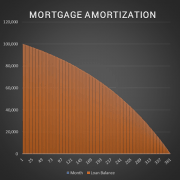How to Use the Apartment Acquisition Model’s Monte Carlo Simulation Module
You may recall that a couple of weeks ago, I began to explore Stochastic Modeling concepts, or the idea of adding probability into my models, to get a more complete picture of the risk-return metrics of an investment. I became interested in the idea, after reading a thesis on the subject by Keith Chin-Kee Leung shared with me by one of our readers. The thesis posits that real estate investment professionals should go beyond the discounted cash flow model, an inherently deterministic model, and add variability to our assumptions. Then, with variability added, we could run thousands of iterations (Monte Carlo Simulations) and analyze the set of iterations using basic statistical principles. Thus, we could better understand the possible outcomes of an investment.
You might also find interesting: How to Run Monte Carlo Simulations in Excel
Finding the idea intriguing and using Mr. Leung’s thesis as a starting point, I built my first Monte Carlo simulation module for real estate. I added it to my Apartment Acquisition Model and last weekend shared the model in our Library of Real Estate Excel Models. As promised, I’m following that post up with a short video I recorded on how to use the Monte Carlo Simulation Module.
You can read more about the model, including find the download link, by checking out the post I wrote when I uploaded the model.
Video Tutorial – Using the Monte Carlo Simulation Module
The module can be turned on and off, making this particular apartment model both a deterministic model (model without randomness) and a stochastic model (model with random variation). Probability has been modeled into eight different assumptions (e.g. rent growth, renewal probability), and the model allows for either uniform or normal probability to be used. Keep in mind, this is my first attempt at using probabilistic analysis in real estate, so I’d love to hear your thoughts, comments, and critiques.
Frequently Asked Questions about Using the Apartment Acquisition Model’s Monte Carlo Simulation Module
What is the purpose of the Monte Carlo Simulation Module in the Apartment Acquisition Model?
The Monte Carlo Simulation Module allows users to introduce probability into their assumptions, enabling thousands of iterations to assess the variability of outcomes and better understand the investment’s risk-return profile. As the post explains, “we could better understand the possible outcomes of an investment” using statistical principles.
What makes this apartment model both deterministic and stochastic?
The model can be toggled on or off for randomness. When the Monte Carlo module is off, it functions as a deterministic model. When turned on, it becomes stochastic by incorporating probability into assumptions like rent growth and renewal probability.
Which assumptions in the model include probabilistic elements?
The model includes probability in eight assumptions, such as rent growth and renewal probability. These assumptions can use either uniform or normal probability distributions.
What inspired the creation of the Monte Carlo module in this model?
The inspiration came from a thesis by Keith Chin-Kee Leung, which suggested moving beyond deterministic discounted cash flow models to include variability through stochastic modeling techniques like Monte Carlo simulations.
How can users access this model with the Monte Carlo module?
The model is available for download in the A.CRE Library of Real Estate Excel Models. The related blog post includes details and a link to access the file.
What feedback is the author seeking from users?
Since this is the author’s first attempt at implementing probabilistic analysis in real estate, he welcomes “thoughts, comments, and critiques” to improve the module and its future iterations.







